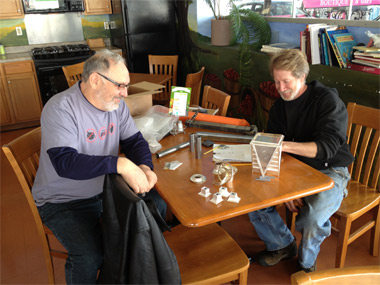
Richard Mawdsley, left, and Richard Smith with unassembled pieces of the ceremonial mace they have been creating for use in commencement ceremonies, beginning with Saturday’s event at the SIU Arena. Smith is a professor of art and blacksmithing at SIU, and Mawdsley is a professor emeritus and a silversmith. Smith also engaged the assistance of several SIU students, an alumna, and a fellow faculty member for this once-in-a-lifetime commission. (Photo Provided)
May 08, 2013
Ceremonial mace forges new graduation tradition
CARBONDALE, Ill. -- Time-honored traditions are helping to forge new paths at Southern Illinois University Carbondale.
Chancellor Rita Cheng commissioned Rick Smith, professor of blacksmithing, and professor emeritus silversmith Richard Mawdsley, with the creation of a ceremonial mace for use in commencement ceremonies. The mace will debut during Saturday’s exercises, set for 9 a.m., 1:30 p.m. and 6 p.m., at the SIU Arena. Complete commencement details are available at commencement.siu.edu/.
A mace is a formal, richly decorated staff topped with an elaborate and symbol-laden head. The use of a mace in formal ceremonies dates back to the Middle Ages. Today, most universities in the United States include a mace in their ceremonies as a reminder, amidst the celebration, of the formality and dignity of the occasion -- the conferring of a degree on students who are seeking to make new lives for themselves through the time-honored means of a university education.
In addition, the mace is traditionally a symbol of authority and signifies the entrance of the chancellor. Om Prakash Agrawal, professor of mechanical engineering and energy processes and recipient of the 2013 Scholar Excellence Award, will carry the mace as commencement grand marshal -- a formal recognition of the power and legitimacy of scholarship and research at the University.
“The mace adds to the dignity of commencement, as did last year’s addition of the beautifully bound University Charter, and reflects our University’s historical commitment to excellence in teaching, research and service,” Cheng said. “Professors Smith and Mawdsley and their team have created a really beautiful symbol that will inspire everyone who sees it.”
Smith, taking a cue from the chancellor, relied on images of the Old Main campus building to inspire his design. Old Main was the oldest building on campus until it was destroyed by fire in 1969. It holds a special place in the collective memory of the University, resonating even with those who were students long after the building was gone. It symbolizes SIU Carbondale’s tradition of accessibility and excellence in education. As such, it was worthy inspiration for a new creation symbolizing tradition. Architectural details from Old Main inspired a roof-like design on the mace-head, and arches and architectural shapes inspired other details.
The selection of two SIU Carbondale faculty artists ensures the respect for tradition will meet a love for the University in the creation of the mace. Smith is the head of the creation project, overseeing the design and the ultimate construction of the mace. He is creating the shaft from pattern-welded Damascus steel rather than from wood. The finished shaft will have a wood-grain appearance, but in metal.
“University commencement maces are traditionally made by metalsmiths, but this is the first one I’ve ever made, and the first one my colleague Richard Mawdsley has made,” Smith said. “It’s a once-in-a-lifetime opportunity; I’m very proud to be part of this.”
Mawdsley is working the silver details. He said he’d always wished he could work on a University mace, and he considers it a great honor to be asked to help create one for a University where he spent many years teaching.
“It’s an honor and a challenge,” he said. “This mace will be part of a legacy I will leave here at SIU -- of course that means something to me, it’s a great honor.”
Smith turned to other SIU artists for the labor-intensive process of preparing the Damascus steel. Alumna Erin Dixon, assistant professor Sun Kyoung Kim, graduate student Patrick Quinn, and undergraduates Timothy Schaeffer and Daniel Widolff, all from the School of Art and Design, were part of creating the mace.
“Besides participating in this commission and being part of the legacy of it, they learned or were able to use metals techniques pioneered at this University,” Smith said.
Final touches to the mace may alter the dimensions slightly, but the finished piece will be approximately 42 inches long and will weigh about 10 pounds.
